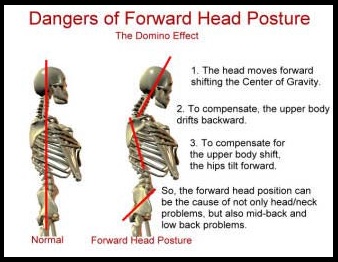
Kalpana Kamdar, a Physiotherapist from Ahmedabad, points out the hazards of a bad sitting and sleeping posture that can dangerously overwork or overload the muscles causing severe pain and stiffness in the head, neck, shoulders and back. Here she recommends ways to correct the body alignment and get a perfect posture. Video of webinar recording below.
DON’T LET BAD POSTURE BECOME A HABIT….!!!
Case Study
A 23-year-old law student came to me with severe pain on the left side of his neck. He had difficulty looking sideways, rotating or tilting his neck and also had pain in his left upper arm. With the exams approaching, he had been studying on his laptop for long hours and had slept with 2-3 cushions under the neck.
Now, is this not a familiar sight? Whether at home or at work… sitting for long hours without taking a break, slouching, with head forward and shoulders slumped. These days, people sit for hours in the so called “Forward Head Posture”, working and playing on the computer, or watching television, without any other physical activity. And, even though the muscles are not moving, they are still contracting, resulting in an overworked, overloaded muscle. Actually, these muscles are not relaxed; they form ‘knots’ or ‘Myofascial trigger points’ resulting in tightness and hence PAIN and LOSS OF MOVEMENT. They can also cause satellite pain in the chest, shoulder, both front and back, and down the arm and into the hand. Satellite pain in the chest, shoulder, and arm can mimic the pain of the onset of a heart-attack. That same satellite pain in the arm can travel down to the wrist and fingers mimicking carpal-tunnel syndrome. Many people get unnecessarily operated for carpal tunnel syndrome trying to fix a problem that is actually coming from their neck.

The head in a forward posture can add up to 30 pounds of abnormal load on the cervical spinal vertebrae (approximately 10 pounds /inch of forward posture). This in turn leads to the postural muscles, to work constantly trying to hold that load and a vicious cycle of pain and musculoskeletal dysfunction, further leading to loss of healthy spine body motion. The entire body becomes rigid as there is general loss in range of movement, increased wear and tear and acceleration of the degenerative process or in other words ageing…!!!
The first and most obvious effect of forward head posture is neck pain.
The muscles of the neck are structured to support the head when it is in alignment with the shoulders. The further the head moves out of alignment, the more stress it creates on the spine and neck muscles.

Forward head postures shifts the center of gravity, causing a domino effect in the body. When the head moves forward, the whole body compensates for the extra load on the neck muscles, which again, are not structured to support the weight of the head when it’s not sitting in between the shoulders. So what happens? The upper body drifts backward and the hips tilt forward, causing pain not only in the head, neck and shoulders, but also in the mid and lower back.
As in the case of my patient, ‘Sleeping wrong’ can also result in a similar scenario… where the head and spinal misalignment also results in pain and stiffness.
A good SITTING and SLEEPING Posture can actually help to prevent all this from happening.
SITTING POSTURE
- Push the hips as far back as they can go in the chair.
- Adjust the seat height so the feet are flat on the floor and the knees equal to or slightly lower than, the hips
- Adjust the armrests so that the shoulders are relaxed.
- Pull up close to the keyboard.
- Position the keyboard directly in front of the body.
- Adjust the keyboard height so that shoulders are relaxed, elbows are in a slightly open position (100° to 110°), and wrists and hands are straight.
- Position the top of the screen approximately 2-3” above seated eye level.
- Sit at least an arm’s length away from the screen and then adjust the distance for your vision.
- Place your telephone within easy reach.
- Use headsets and speaker phone to eliminate cradling the handset.
- Take short 1-2 minute stretch breaks every 20-30 minutes. After each hour of work, take a break or change tasks for at least 5-10 minutes.
SLEEPING POSTURE
Position #1

In this situation, it is recommended to sleep on the side with legs up towards the chest. As this is the fetal position, the body is very relaxed in it. To not put imbalanced pressure due to the legs, it is best to have a pillow between them.
Position #2

Sleeping on the back is also fine, but remember, our bodies are not flat. Due to this, pressure distributes unevenly causing pain. So it is best to have the pillow below the knees, this pushes your back into the bed. Having another small towel between the bed and the little curve of the back will counter balance this giving support throughout the body.
Position #3

It is NOT recommended to sleep on the stomach when you have back or neck pain, but sometimes it can’t be helped. In such cases, place a pillow under the pelvis and lower abdomen. For the head, try sleeping without a pillow, as it will cause neck strain.
(This is the second article of a series on good posture and good health by Dr. Kalpana Kamdar Clinical Physiotherapist practising for more than 20 years at the Swayam Physiotherapy Clinic, in Ahmedabad, India.)
Image credits
Img 2 : Dalton, E (2016) The 42 pound head
Retrieved from http://www.cervipedic.com/2016/03/15/healthy-neck-posture/
Img 3 : courtesy www.pinterest.com
Img 4 : Retrieved from http://trucontour.com/back-pain-sleep-positions






